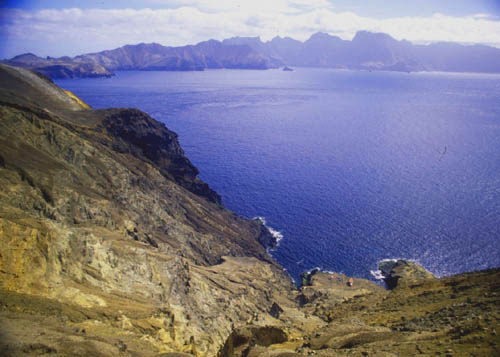 Where
Where Where
WhereThe Juan Fernández Islands, located 670 km off the central coast of Chile, are frequently referred to as a temperate counterpart to the Galápagos Islands. Both of these island groups are characterized by isolated floral and faunal communities that exhibit high degrees of endemism. The archipelago consists of three islands: Isla Robinson Crusoe (Más a Tierra, 47.9 km2), Isla Santa Clara (2.2 km2), and Isla Alejandro Selkirk (Más Afuera, 49.5 km2).
The Juan Fernández Islands have received national and international recognition
for their biological uniqueness - designated a Chilean National Park in 1935
and an UNESCO International Biosphere Reserve in 1977 and nominated for World
Heritage status in 1995. Over 60% of the native plants are endemic to the archipelago,
including 12 endemic genera and one endemic family (Lactoridaceae). Thirty-five
of the 46 mollusks and more than 440 of the 660+ species of invertebrates are
also endemic. There are no native amphibians or reptiles, and the only native
mammal is the endemic Juan Fernández fur seal (Arctocephalus philippii).
The Juan Fernández Islands are home to nine native terrestrial bird species.
Three of these are endemic to the archipelago, and an additional three subspecies
are also endemic to the islands (1). Six species of seabirds breed on the islands,
of which two are endemic to the islands, and another two are endemic to Chile.
 The plight of the archipelago’s
endangered natural systems has also been recognized. The International Union
for the Conservation of Nature and Natural Resources (IUCN) identified the Juan
Fernández Islands as one of the world’s 12 most threatened national
parks, and in 1984 the International Council for Bird Preservation (ICBP) designated
the islands as one of the 10 highest priority regions for seabird research globally.
In 1998, BirdLife International listed the islands as a Priority 1 (critical)
Endemic Bird Area of the World. The Alliance for Zero Extinction (AZE) targeted
the Juan Fernández Islands as a priority site in 2002, an area in most
urgent need of conservation investment to prevent imminent species extinctions.
The plight of the archipelago’s
endangered natural systems has also been recognized. The International Union
for the Conservation of Nature and Natural Resources (IUCN) identified the Juan
Fernández Islands as one of the world’s 12 most threatened national
parks, and in 1984 the International Council for Bird Preservation (ICBP) designated
the islands as one of the 10 highest priority regions for seabird research globally.
In 1998, BirdLife International listed the islands as a Priority 1 (critical)
Endemic Bird Area of the World. The Alliance for Zero Extinction (AZE) targeted
the Juan Fernández Islands as a priority site in 2002, an area in most
urgent need of conservation investment to prevent imminent species extinctions.
In 1997 the Dutch Cooperative – Juan Fernández Project began engaging the local community in a variety of conservation programs. These efforts encouraged the residents to understand, take pride in, and protect the islands’ native ecosystems. Many local islanders are quite eager to participate in the conservation of the islands and have already adopted eco-friendly attitudes and activities.
(1) Roy et al. 1999. Oryx 33(3): 223-232